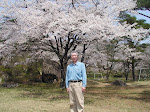
This afternoon I saw skunk cabbages come out in the marshes.
The plants are called ' 水芭蕉(Mizubashou) ' or, 'Basho in the waters', because they look like the leaves of a basho tree, a variety of banana tree that bears no fruit.
Matsuo Basho(松尾芭蕉)is said to have been named after this basho tree, because he planted it in his garden and loved the basho tree.
According to the PREFACE in The Narrow Road to Oku by Donald Keene, the name Basho was derived from a tree in his garden: in 1681, when he moved to a bleak area of the city of Edo, he planted a basho tree in order to improve the appearence of the garden. The basho, a variety of banana tree that bears no fruit, had a special meaning for poets: its broad green leaves are easily torn by the wind, a ready symbol for the sensitivity of the poet. Visitors began to refer to the place as the Basho-an (Cottage of the Basho Tree), and before long Basho was using the name for himself.
Skunk cabbages are also used to denote another plant ' 座禅草(Zazensou) ', which is similar to
' 水芭蕉' in the form or shape, but different in the color and the place where they grow.
' 水芭蕉' has green leaves and white covers for its flowers, grows in the marshes, and blooms early in summer, so it is used as the season word of summer.
' 座禅草' has purple leaves and dark purple covers for its flowers, grows in the hills or in the mountains, and blooms in spring, but it isn't used as the season word. Maybe this is because it can't be found nearby.
The similarity is that both of them look as if they sat practising zazen.
Skunk cabbages
returned to life
spring light
春光や座禅草野に生き返る
Shunkou ya zazensou no ni ikikaeru
Skunk cabbages
meditating
first zazen
水芭蕉ただ黙想す初座禅
Mizubashou tada mokusousu hatsu zazen
― Hidenori Hiruta




